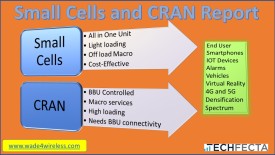When the CBRS is finally released to the public, the carriers want to grab as much spectrum as possible. The thing is, they need partners to provide coverage. Currently, they are relying on Wi-Fi to offload indoor coverage, but that model is fading. The carriers will need to rely on the partners. That’s where a mini MVNO can make a difference.
The model has to change. The release of the CBRS had the carriers blinded with spectrum greed, forcing the FCC to change the rules so they would have more spectrum for a longer time. The overall solution was lost in their blind greed for spectrum. They forgot that they don’t want to spend the money to expand indoor coverage. Honestly, what were they thinking? That is where the CBRS will shine, indoor LTE and 5G coverage. It’s very limited coverage areas will make it ideal for indoor solutions.
For a list of products to support Wade4Wireless, click here!
Would you sign up for a membership site with private content? If so, email me at wade@techfecta.com and write Membership.
That paired with the fact that the carriers don’t want to invest in DAS or indoor coverage anywhere they don’t have to is going to make a new business model for mini MVNOs. That’s where a smaller ISP or carrier could offer coverage in a limited area. This would be the rise of a mini MVNO.
The carriers are missing a golden opportunity if they don’t pair with smaller carriers and ISPs. They could ban together to get CBRS spectrum in buildings around a city or a region. This could make the growth of indoor coverage much cheaper than if the carriers did it themselves. A smaller company using CBRS could pair with any carrier to provide the coverage needed to improve indoor coverage.
That’s why being a mini MVNO for any carrier would make sense. The idea that the carriers won’t spend to improve indoor coverage helps a smaller company look more and more valuable. The carriers can continue with the Wi-Fi offload model, but I don’t see it as sustainable. Wi-Fi in an airport where you have to pay for the access doesn’t make sense when you pay a carrier for unlimited coverage. Why pay for the Wi-Fi? You already pay the carrier for unlimited coverage.
The example I have is when I fly from BWI airport. The airport has limited free coverage, but email on your device quickly eats that up then Boingo wants paid to use their unlimited coverage. However, I have great carrier coverage inside the airport, so I turn off Wi-Fi and rely on the LTE coverage that is there today, and it works very well. Why go to Wi-Fi when you have unlimited data with a carrier?
So for smaller companies that may have CBRS spectrum in an area where the carrier coverage is spotty at best and the Wi-Fi is very limited or nonexistent, you have an opportunity. The opportunity to create a small business model and allow offloading from the carriers in a small controlled environment.
Now, how do you make money off this model? Good question! We know that the carriers won’t pay you squat unless they have to. So one idea is you could ink a deal with one carrier exclusively to see if they would give you some monthly payment, but I would think it’s going to be a very small payment. Then there is the idea that you could get local subscribers. They would sign up to a point. Then local businesses may want to have coverage if they can use it for their back office and business systems as well as customers.
There are a few ideas. I hate to say it, but you may have to build it first. To be honest, I hate the “build it, and they will come” model because if it’s there, no one wants to pay, ask anyone who rolls out free Wi-Fi.
The idea is to get the local businesses or building owners to buy in first. Advertise so that people know that you’re offering the coverage and not the carrier. Make sure people see the difference between what you offer and the Wi-Fi in their business. If you can save someone from a large backhaul cost every month, they would buy in. Make it valuable to the local businesses and maybe the carriers will want you as a very small partner.
This is my business case for the mini MVNO using the CBRS spectrum. The FCC won’t give anything else to the small business; those days are gone. This is going to be the best you can do for now.
The CBRS equipment is out there, and the way to license is cost-effective. Let’s put together some smaller LTE and 5G systems while we still can. The FCC should be opening up the CBRS someday soon, hopefully. I know they had the big press release, but what can we do today? Seriously, who grabbed spectrum so far outside of the carriers or major OEMs to test?
So when the spectrum is free, smaller companies can start working with SpiderCloud, Ruckus, Ruckus, Airspan, and the other OEMs to roll systems out. The major OEMs may not be so easy. I was working with a smaller company that wanted to roll out Nokia and Ericsson gear, and it would take them months before they could deliver anything and they really weren’t interested in any order under 50 units. Just so you know, deal with the OEMs that want to deal with smaller companies. Not every OEM cares about smaller businesses and enterprise the way some do.
Indoor coverage for LTE and 5G are critical to all carriers. Businesses will rely on indoor coverage; the enterprise will build private LTE and 5G systems, new carriers will arrive offering limited indoor coverage. There will be disruptors in this industry.
Something to think about, as VRAN grows and becomes the new normal, smaller CBRS indoor units will make more sense. Currently, CRAN is pushing the limits of VRAN so the CBRS units will need to have the controller remote so they can be deployed anywhere. It’s going to be like the Ericsson DOT system on the controller will be off premises, not the convoluted system that they currently have. It will be cleaner and remotely controlled in the cloud, more or less.
The major OEMs will lose ground to new open source equipment providers, learn more at;
- https://telecominfraproject.com/openran/
- https://wade4wireless.com/2018/07/05/what-are-open-ran-systems-pros-and-cons/
- http://www.xran.org/
- https://www.sdxcentral.com/articles/news/xran-open-vran-and-openran-whats-the-difference/2018/04/
The carriers realize that the last mile is losing its value with the acceptance of unlimited data. They are already looking for new revenue sources. Spectrum is going to lose its value with more and more unlimited data plans. They have to come up with a new way to make money instead of crushing contractors pricing to save money. The model must change.
I can’t wait to see who will be the last mile disruptor. I thought it would be Google, but they didn’t have the stomach to continue to roll out FTTH, so it’s hard to believe they could roll out anything beyond Wi-Fi in a local region. I hope they deploy CBRS, but they need to find a very cheap and easy way to do it. Let’s face it. You need a strong heart and determination to deploy any wireless system. Google hasn’t proved they have either in deployment. Anyone who climbed towers can tell you how hard field work can be. Google supports the CBRS in the background, but I don’t see them deploying much of it.
The carriers realize that the last mile is losing its value with the acceptance of unlimited data. They are already looking for new revenue sources. Spectrum is going to lose its value with more and more unlimited data plans. They have to come up with a new way to make money instead of crushing contractors pricing to save money. The model must change.
I can’t wait to see who will be the last mile disruptor. I thought it would be Google, but they didn’t have the stomach to continue to roll out FTTH, so it’s hard to believe they could roll out anything beyond Wi-Fi in a local region. I hope they deploy CBRS, but they need to find a very cheap and easy way to do it. Let’s face it. You need a strong heart and determination to deploy any wireless system. Google hasn’t proved they have either in deployment. Anyone who climbed towers can tell you how hard field work can be. Google supports the CBRS in the background, but I don’t see them deploying much of it.
For those of you that don’t know:
- VRAN – Virtual RAN
- CRAN – Centralized RAN, radio heads controlled by a central BBU, slightly different from cRAN, Cloud RAN.
- RAN – Radio Access Network
- BBU – Baseband Unit
- FTTH – Fiber to the home
- MVNO – Mobile Virtual Network Operator, someone who may use another carrier’s network as their own, for example, Virgin Mobile and Boost Mobile.
- DAS – Distributed Antenna System
- CBRS – Citizens Broadband Radio Service, 3.5GHz spectrum in the USA.
- Wi-Fi – honestly, you don’t know what Wi-Fi is? And you’re reading this? Google it then get lost! This is for real engineers and technicians.
Thank you for your support and your time. And good job on learning all you can in the wireless industry, you are amazing! Now, go out and impress people!
Would you sign up for a membership site with private content? If so, email me at wade@techfecta.com and write Membership.
Do you want an occasional email with free PDFs of these reports along with book and training offers? Read posts like these offline!
Be smart, be safe, and pay attention!
See Ya!
More products from TechFecta and Wade4Wireless that support WADE!
The foundations below do beautiful work, spreading love when all seems lost.
Climbers can get seriously injured and/or die on the job. Support the workers who build and install the wireless systems!
Together we can honor and remember the fallen in our wireless family.
Hubble Foundation helps the families of climbers in a time of need and beyond with financial support and counseling!
Tower Family Foundation supports the families of tower climbers at the time of crisis when a climber falls with financial assistance and more.











 Putting together your smart city tech solutions, planning, development, and more…TechFecta! Guiding you to a better plan through consulting!
Putting together your smart city tech solutions, planning, development, and more…TechFecta! Guiding you to a better plan through consulting!






























